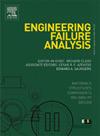Surface integrity and its effect on the fatigue life of receding grooves in 300 M steel bolt under the surface rolling process
IF 4.4
2区 工程技术
Q1 ENGINEERING, MECHANICAL
引用次数: 0
Abstract
Ultra-high strength steel bolts are high-performance fasteners used in aerospace applications. Due to prolonged exposure to high loads and impacts, bolts are susceptible to fatigue failure, with fatigue fracture at the receding groove being one of the primary failure modes. In this work, surface rolling process (SRP) with varying rolling force is applied to treat receding groove of 300 M steel bolt. A comparative analysis is conducted on surface geometric state, microstructure, and residual stresses, and their influence mechanism on fatigue life are discussed. After SRP, the surface roughness of bolt receding groove is decreased, and the gradient microstructure and compressive residual stress (CRS) field are induced. At a rolling force of 380 N, the surface integrity of bolt sample is comprehensively improved, causing an 8.45-fold enhancement in fatigue life compared to the BM sample. All surface integrity factors have their own contributions in improving fatigue life, the moderately refined gradient microstructure and high amplitude CRS field are the primary factors for enhancing fatigue life, with high amplitude CRS field being more critical. However, synergistic improvements in surface integrity cannot be ignored, and the mechanism of SRP for improving the fatigue life is the synergistic effect of high amplitude CRS field, excellent surface geometric state and fine gradient microstructure.
表面轧制条件下300m钢螺栓后退槽的表面完整性及其对疲劳寿命的影响
超高强度钢螺栓是用于航空航天应用的高性能紧固件。由于长时间暴露在高载荷和冲击下,螺栓容易发生疲劳破坏,后退槽处的疲劳断裂是主要破坏形式之一。采用变轧制力的表面轧制工艺处理300m钢螺栓的后退槽。对表面几何状态、微观组织和残余应力进行了对比分析,探讨了其对疲劳寿命的影响机理。SRP后,螺栓退槽表面粗糙度降低,并产生梯度显微组织和压缩残余应力场。在380 N的轧制力下,螺栓试样的表面完整性得到全面改善,疲劳寿命比BM试样提高了8.45倍。各表面完整性因素对提高疲劳寿命都有各自的贡献,适度细化的梯度组织和高幅值CRS场是提高疲劳寿命的主要因素,其中高幅值CRS场更为关键。然而,表面完整性的协同改善是不可忽视的,SRP提高疲劳寿命的机理是高幅值CRS场、优异的表面几何状态和精细的梯度组织的协同作用。
本文章由计算机程序翻译,如有差异,请以英文原文为准。
求助全文
约1分钟内获得全文
求助全文
来源期刊

Engineering Failure Analysis
工程技术-材料科学:表征与测试
CiteScore
7.70
自引率
20.00%
发文量
956
审稿时长
47 days
期刊介绍:
Engineering Failure Analysis publishes research papers describing the analysis of engineering failures and related studies.
Papers relating to the structure, properties and behaviour of engineering materials are encouraged, particularly those which also involve the detailed application of materials parameters to problems in engineering structures, components and design. In addition to the area of materials engineering, the interacting fields of mechanical, manufacturing, aeronautical, civil, chemical, corrosion and design engineering are considered relevant. Activity should be directed at analysing engineering failures and carrying out research to help reduce the incidences of failures and to extend the operating horizons of engineering materials.
Emphasis is placed on the mechanical properties of materials and their behaviour when influenced by structure, process and environment. Metallic, polymeric, ceramic and natural materials are all included and the application of these materials to real engineering situations should be emphasised. The use of a case-study based approach is also encouraged.
Engineering Failure Analysis provides essential reference material and critical feedback into the design process thereby contributing to the prevention of engineering failures in the future. All submissions will be subject to peer review from leading experts in the field.
 求助内容:
求助内容: 应助结果提醒方式:
应助结果提醒方式:


